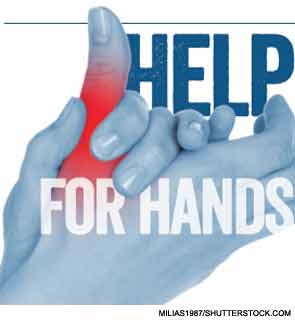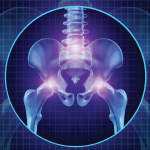
Thumb carpometacarpal (CMC) joint osteoarthritis (OA) is the second most common form of hand OA, affecting between 20% and 30% of the general population.1,2 Thumb CMC joint OA is more prevalent in females than males, increases with age, and has been associated with hand pain and loss of functional hand use.3 While CMC arthroplasty and fusion are options for patients, they may not be optimal. This article describes how OA can affect hand anatomy and kinematics, and discusses conservative interventions including splinting, exercise techniques, and physical agent modalities.
Anatomy of the Thumb CMC Joint
Bony articulation: The trapezium bone of the wrist and the first metacarpal of the thumb comprise the thumb CMC joint. The biconcave/biconvex nature of the articulating surfaces of the thumb CMC joint is unique: the trapezium is shaped like a saddle with both a concave surface and a convex surface, and the first metacarpal has corresponding convex and concave surfaces.4 The unique shape of the articulating surfaces allows for movement in flexion/extension, abduction/adduction, and the combined planar movement of opposition.
Ligaments: The ligaments of the thumb CMC joint are the anterior oblique ligament, posterior oblique ligament, radial collateral ligament, ulnar collateral ligament and intermetacarpal ligament. As a group, the ligaments guide the movement of the first metacarpal on the trapezium and serve to check excessive movement and unwanted joint play, which provide joint stability. All of these ligaments restrain the movement of opposition. The anterior oblique and ulnar collateral ligaments also check extension while the radial collateral ligament checks adduction. The anterior oblique ligament, which connects the anterior tubercle on the trapezium to the anterior surface of the metacarpal, is also termed the “beak” ligament.
Joint kinematics: The thumb joint moves in multiple planes. With the forearm in neutral position, the “hitchhiking” upward movement of the thumb is extension, and movement downward in the plane of the palm is flexion. A 90-degree movement of the thumb away from, and return to, the index finger is abduction and adduction, respectively. Opposition is defined as axial rotation of the thumb resulting in the pad of the thumb facing the pads of the digits. Thumb opposition to the small finger is a complex multiplanar movement. It begins with abduction. The metacarpal then rotates inward around the longitudinal axis to face the pads of the digits.
The convex/concave rules of joint motion apply to the movements of abduction/adduction and flexion/extension. During abduction/adduction, the convex base of the thumb metacarpal glides laterally on the concave portion of the trapezium. During flexion/extension the concave portion of the thumb metacarpal both glides and rolls toward the direction of the movement on the convex portion of the trapezium.


